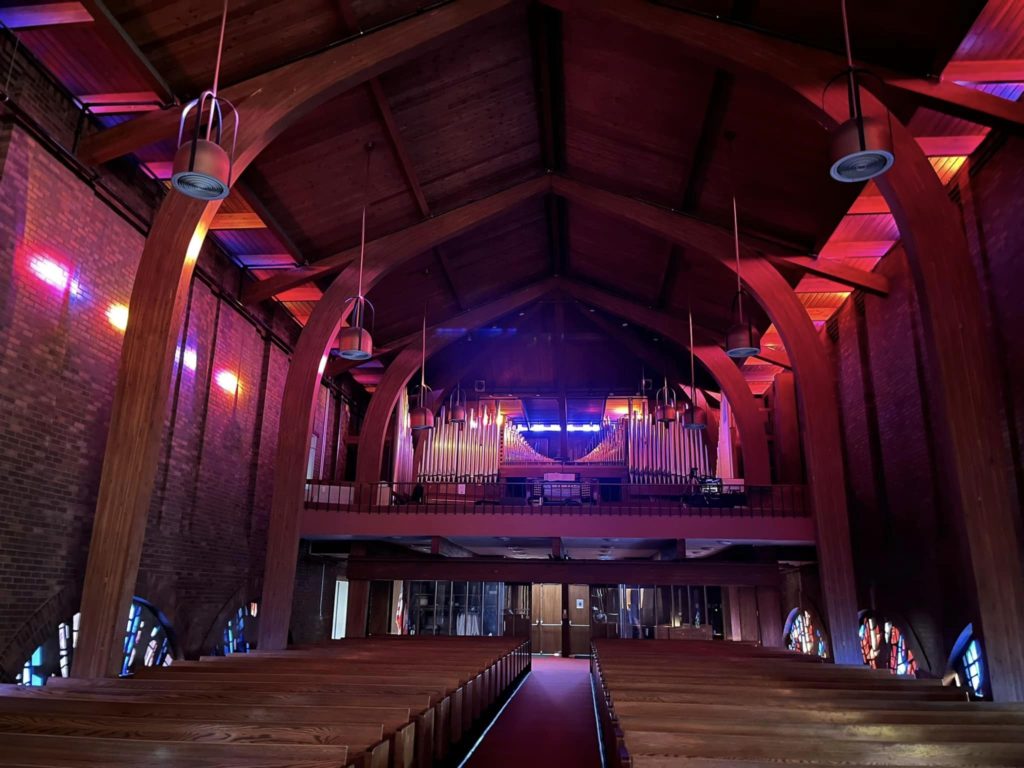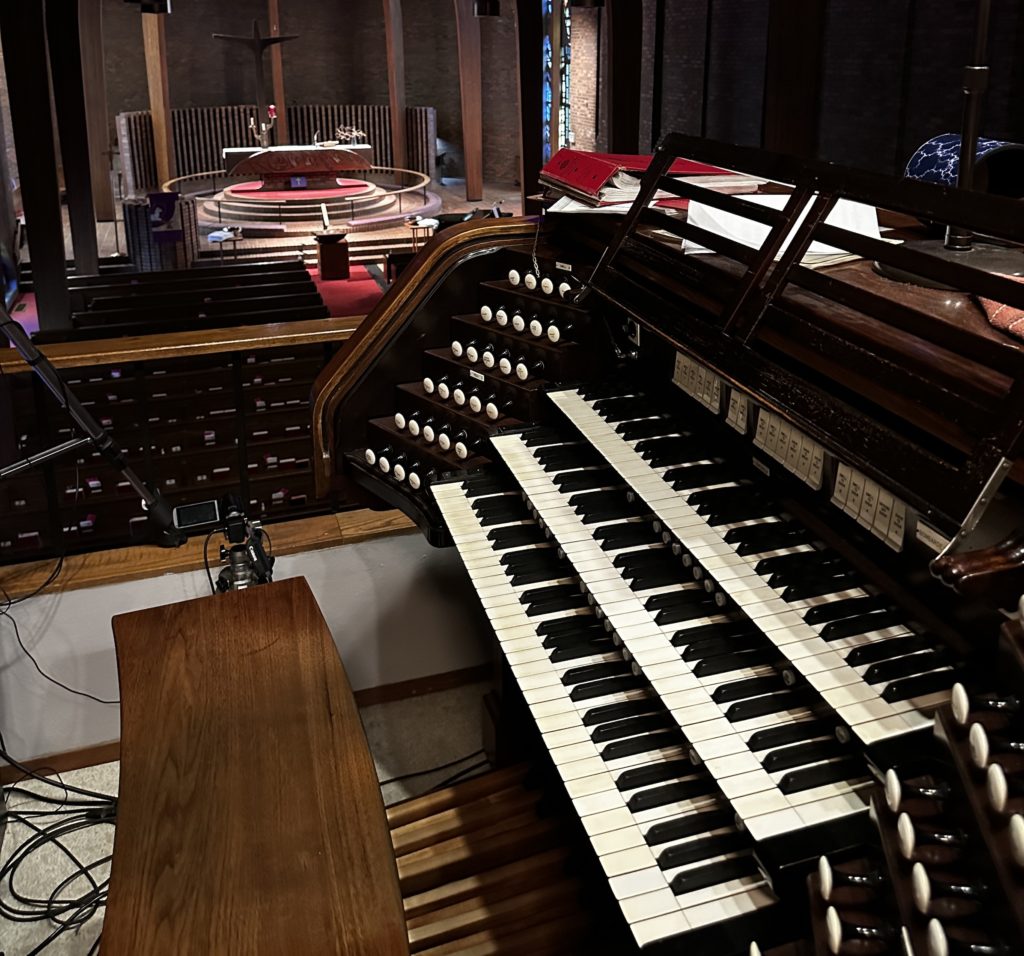Gloria Dei’s organ has been a deep source of pride among the congregation since the mid 1930s. Located in the balcony of the main sanctuary, the present organ is our fifth organ and was built by Michael Gardner. Incorporating elements from four different organs, the current organ has voices appropriate for a wide range of music, including both Baroque and Romantic compositions.
Gloria Dei’s first pipe organ was bought used in 1937, and had 8 ranks (sets) of pipes attributed to William Schuelke of Milwaukee, WI. The firm of Balcom & Vaughan of Seattle built our second, third and fourth organs. Their Opus 526 (1951) and the Schuelke organ was moved to what is now Luther Hall when the church relocated to the west side of Olympia in 1956. At that time 3 ranks were added, as well as an electric action and a 2-manual console. Further modifications came in with the addition of Opus 526-A (1968). This modified system was then moved to the present sanctuary and enlarged to 18 ranks; Opus 526-B (1981) enlarged Opus 526-A to 24 ranks. The result was strong basses and strong trebles yearning for unisons to balance the ensemble.

With the 1951 console failing, a search in 1993 yielded an entire Romantic-era organ for sale in Detroit, MI. It had 29 ranks and was originally made by Hook & Hastings of Boston in 1893 for the First Parish Unitarian in Brookline, MA (their Opus 1557). It had been re-installed in Detroit’s Temple Beth El in 1902 (as Opus 1957) with an additional 7 ranks and a 3-manual console made by Casavant Freres of St. Hyacinthe, Que. In 1992, after moving Opus 1957 to a new Temple Beth El (their Opus 935); plus direct-electric windchests made by Wicks Organ Company of Highland, IL in 1935 (their Opus 1336), former Gloria Dei organist Robert Pedergrast went to Detroit to play it, and he liked it. It had strong unisons, and with the help of Gloria Dei member Marvin Schurke, a new console was designed with a combination of the Detroit organ and Opus 526-B with minimal duplication of the voices.
A truckload of organ parts arrived from Detroit on December 28, 1993, and Michael Gardner (then of Tacoma) and Gloria Dei volunteers pre-assembled most of the Opus 5 in what is now the Gloria Dei Pre-school space. Opus 526-B was dismantled after Easter 1994, and most of its parts were incorporated into Opus 5. Volunteers washed parts, painted pipes, refinished woodwork, re-wired windchests to conform to the Uniform Electrical Code, and built platforms in the rear corners (to support the Swell and Choir enclosures) and over the aisles and balcony landings (to support Great and Pedal pipes). Together, Paul Olson, Andy Opsata, Robert Pendergrast, George Phillips, Marvin Schurke, Paul Schurke, Jeffrey Sprengel, Ron Tallman, John Vatshell, and Rey Wicklund volunteered about 8,000 hours on the project. Associated Organ Builders (then of Auburn, WA) rebuilt the Casavant console with solid-state electronics.
Opus 5 was first used on Christmas Eve of 1994. Douglas Cleveland (an Olympia-native and the 1994 American Guild of Organists Young Artists Competitions winner) played the first of four dedicatory recitals on May 5, 1995. Builder’s Recitals by Michael Gardner, Robert Pendergrast, and Jeffrey Sprengel completed that series.

In 1998, Michael Gardner added the Swell 8’ Vox Humana and Choir 4’ Principal. In 2014, Britson Organ Works added the Swell/Pedal 16’ Posaune and Pedal 32’ Contre Bombarde (both given in honor of Dan Colgan’s third anniversary as Gloria Dei’s organist).
Specifications of the Gloria Dei Organ
Michael Gardner Opus 5 (1995, 1998), incorporating Hook & Hastings Opus 1557 (1893), William Schuelke (~1910), Casavant Freres Opus 935 (1922), Wicks Opus 1336 (1935), and Balcom & Vaughan Opus 526 (1951), 526-A (1968), 526-B (1981). Britson Organ Works (2014). Three manuals & pedal; 60 stops; 3466 tones (3,442 pipes + 24 electronic) in 63 ranks.
GREAT ORGAN (façade and center)
DIAPASON 16’
MONTRE 8’
PRINCIPAL 8’
VIOLA d’GAMBA 8’
DOPPELFLUTE 8’
MELODIA 8’
OCTAVE 4’
ROHRFLÖTE 4’
TWELFTH 2-2/3’
DOUBLETTE 2’
MIXTURE III rks. (1-13’)
MIXTURE III-IV rks. (2’)
TRUMPET 8’
TOMPETTE 8’
CLAIRON 4’ (ext. Trumpet)
CHIMES
15 speaking stops; 1159 pipes in 19 ranks
CHOIR ORGAN (under expression)
GEIGEN PRINCIPAL 8’
VIOLA d’GAMBA 8’
VIOX CELESTE 8’ (tc)
UNDA MARIS 8’
GEDECKT 8’
QUINTADENA 8’
PRINCIPAL 4’
FLUTE d’AMOR 4’
NASAT 2-2/3’
PRINCIPAL 2’ (ext.4’)
KOPPEL FLÖTE 2’
TIERCE 1-3/5’
MIXTURE III-IV rks. (1-1/3’)
Prepared windchest
CLARINET 8’
TREMULANT
14 speaking stops; 1037 pipes in 17 ranks
SWELL ORGAN (under expression)
BOURDON 16’
DIAPASON 8’
STOPPED DIAPASON8’
SALICIONAL 8’
VOIX CELESTE 8’ (tc)
OCTAVE 4’
HARMONIC FLUTE 4’
VIOLIN 4’
FLACH FLÖTE 2’
LARIGOT 1-1/3’
CORNET III rks. (2-2/3’)
POSAUNE 16’
TROMPET 8’ (ext. Posaune)
OBOE 8’
VOX HUMANA 8’
TREMULANT
15 speaking stops; 976 pipes in 16 ranks
PEDAL ORGAN (sides and center)
CONTRE BOURDON 32’
PRINCIPAL 16’
DULCIANA 16’
BOURDON 16’
BOURDON 16’ (Swell)
OCTAVE 8’ (ext. 16’ Principal)
FLUTE 8’
DOLCE 8’ (ext. 16’ Dulciana)
OCTAVE 4’
FOURNITURE IV rks. (2-2/3’)
CONTRE BOMBARDE 32’
BOMBARDE 16’ (ext.32’)
TROMPETTE 8’ (Great)
CLAIRON 4’ (Great, ext. Trompette)
POSAUNE 16’ (Swell)
TROMPET 8’ (Swell)
16 speaking stops; 294 pipes as 11 ranks

